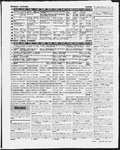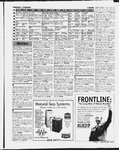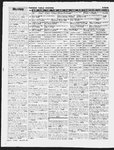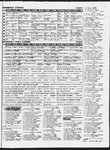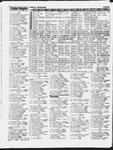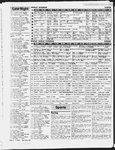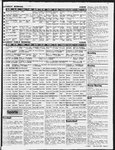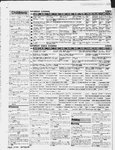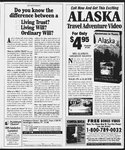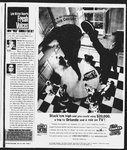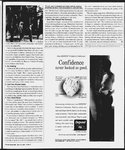| OCR Text |
Show SUNDAY The Salt Lake Tribune Guardians t Fite “Edit View at NPSprotect submergedrelics Theme GraphicsWindow Sunday, May23, 1999 AscView Help Ve)eh eashe BAGSiL) (ONPORRone Scake Vases)RRS I @ Continued from J-1 archaeological sites.” And,he says, lawmakersare Ei Che eta gists on land to draw information about the past and assess what would happen when you dumped a reservoiron topofit, says ffHorewrecee a allowing the problemto persist Thefocus of Lenihan’s angstis the 1987 Abandoned Shipwreck Act, a lawpassed by Congress, sponsored by then Sens. Al Gore and Bill Bradley, both nowpresi- Lenihan. Afterfive years, the group re- leased its findings, which remain today as the handbookof basic underwaterarchaeological prin ciples. In the process, the Park wv NOS Control Mon vice decided to make the un derwater archaeological team a permanent fixture of the agenc: dential candidates. The law asserted U.S. title to any submerged shipwreck. Thenit transferred thosetitles to the states in or on finders-keepers: salvage operators and treasure hunters who found wrecks could keepor sell called upon to travel anywhe = eeenen %) whosesubmergedlandsthe vessels were located. What the ShipwreckAct did wasallowstatelegtures to dictate how sunken vessels would be regulated. Most states decided to adopta policy of | ;, the country and sometimes the world to assess the condition and value of submerged resources. And, while most other system wide units of the Park Service have headqu 's in Washing: ton or Denver CRU managed to. keep its home ir nta Fe, to the ch. rin of some agency officials. There has not be Park im ca Dab eH (_] doserrat LOOOERHEAD | anyantiquities theyrecovered, Service directorinthelast 30 whethergold bars or cannon years that has not que:»stioned balls. Forthe Park Service, the law created some unusualsituations. h > in Santa Fe,” smiles Cook, who wasinstrumental in ating SCRU. “But SantaFe is wher ourbest cultural resource people are and it made sense.” Plus, the Southwest is cenarious cross-countrymissions, leading In national parks wherethe gov- ernmentdoesnothold “feesimple”title to the land but in- stead administers a hodgepodge oflandclaims, treasure hunters can legally acquire a permit from astate to excavate a wreckoff the bottom ofa lake beds or seabed even whileinside the national Using a globalpositioning satellite tracking system, the National Park Service developsdetailed computer mapsof underwaterterrain and eeeartifacts, allowing park service managers to know whatspecific cultural resources are beneath the surface and wherethey arelocated. Lenihan to tell oneinquisitive di r, we do not swim to. The unusual SCRUacronym park. “Right now at AssateagueIs- alsohasfacedits shareofscruti: ny. landNational Seashore[offthe Marylandcoast] wehavea trea sure hunter operating inside the boundariesofthe parkandit just makesme sick,” chemistry, differences in the colorof soil layers or “stratigraphy” when underwater and howtextures of soil change when submerged “We had to look at each one of these things used by archaeolo- says Lenihan. “It doesn't meanthe person who got the permit is bad, it means we as a society were stupid to give him the permit.” Lenihan is the U.S. representa- tive to the International Committee on UnderwaterCultural Heritageof the International Council on MonumentsandSites, a UNESCO-relatedorganization. The group has adopted international bylaws that do not condone the “trafficking in antiquities” aspect of salvaging, arguing that profit motives will supersedethe need for scientific analysis of toric underwaterwrecks. his “Once the government gives its blessing to taking stuff off the seabed andselling it to the high est bidder at Christie's [thewell known auction house], you're let ting the marketvaluedictate what happens under the sea {rather than] any sense for understandingthe past,” says Lenihan “I don't see treasure hunters as having horns,I just see them what you'd expect when wecre. ate an environment that is conduciveto this unchecked behavior.” While the sunkenvessels are called “wrecks,” they can be priceless sources of information. “Manyofthesevesse re froma period of time we know verylittle about,” hesay: knowmore about Phoenician vessels than we doabout the vessels that were the backbone of Ameri- can commercein the 1600s.”” Given thecurrent negativeat titudes towardgrave-robbing and pot-hunting in pre-Columbian In. dian haunts of the Southwest, government sanctioning ofloot ing of underwaterarchaeological treasuresstrikes Lenihanasab: surd. Muchofthe skewedpublic perception stems from media cov. eragethat glorifies and romanticizes underwatertrea sure seekers. National Geographic is oneof the worstoffendersin this men: tality they just show some outrageous garbagethat pla this syndromethat you hav quire something to appreciate “he says. “Everybodyhas the riright to go through environmen- taltoilet trainingonce,but soci- today shouldbe at a point where we knowbetter.” Ithough Lenihanandhis SCRU teamdive on hundreds of shipwrecks and submergedIn- dian villages, ranch houses and other underwatercultural sites, they rarely if ever bring artifa to the surface. Sometimes they will moveparticularly tempting artifacts to safelocations, such as burying thembeneath government boatdocks. “Veryfewof thesites wefind areeverput off-limits to dive says Lenihan. “There are some sites we knowabout that we don’t talk about because theyare very sensitive. For instance, [there are] vessels that have human re- mains on themorhavea lot of portable artifacts strewn about that createtoo great of a temptation In one recent case. SCRU rec ommended that a submerged vessel be excavated, raised, con served and curated for people on land to appreciate. The find is the Civil War submarine H.L. Hunley. which conducted the first successful underwater atta an enemy ship, sinking the U: Housatonicin 1864. Then the Hunley mysteriously disap: peared. The submarine was found in 1995 in the outer harbor of wasanational resource and cern over submerged cultural turned it overto the proper au thorities,” says Lenihan. “We have recommendedthe Hunley be raised andput ondisplay.” Lenihan doesn't arguethat ex: and natural resources stemmed fromthe Bureau of Reclamation’s the western United States in the late 1950s and 1960s. Damrivers wereflooding canyons that once were home to vanished civi tions. There was debate over what would happen to the Ana sazi Indian dwellings, kivas and “There's no questionif you dig burial middens when they were upa wholeshipwreck youarego- inundatedwith ing to learn something, but at what cost?.” he says. “I imagine if you had a bunchof medical students walking around theplaza water ~The Monkey Wrench Gang and all that was keyed moreto theloss of natural features from the dams, but what the archaeo: al organizationprofessor ernment would allowan agency to be knownby an acronympro nounced“Screw.” Lenihan face- tiously wrotebackthat the “Feder ecutive Council on AcronymLaundering”hadre jectedothersuggestions suchas the “Bureau of Underwater Resource Protection” and “Submerged Historic Investigative Team Suchirreverencefromgovern ment bureaucrats may beex: cused when youconsider Leni herewith axes, they wouldlearn logical community was con hanhas spent most of his Park quitea bit fromthe local popula tion.” SCRU’s primary mission is to cerned about was theloss of more than 2,000 known sites in Glen Service career underwater breathing bottled oxygen. Yet that has not stopped himfromco- Canyonand Lake Mead,” says survey, mapand documentsub: Lenihan, who was hiredfresh out ad school to conduct a res. mergedresources in computer databases. Then park managers ervoirinundationstudy on cul tural sites in the West will knowwhat's beneath the water and howbest to protect it. Theteam was charged with finding out what would happen to archaeological sites once they “The work they are doing may Charleston, S.C.. by a dive team not be widely known, but it is vi led by novelist Clive Cussler. SCRU was summoned by theNa’ al Center to verify the find and evaluate the conditionof th tional Park Service. “We're finding that not only do allyimportant,” John Cook, went underwater. One theory was Intermountain Regiondirector of the legendary vessel weneed to document thesub- When Mr. Cussler found it, instead of trying to go through some sleazy process andclaimit merged cultural resources, but also thenatural resources found beneaththe waters in our na. tional park units. as treasure, he dealt with it re. sponsibly andrecognizedthis dam-buildingjuggernaut across cavatinga shipwreckcanleadto better understanding. But he challengesthenotionthat all sunkentreasures must beraised to be enjoyed A fewyears ago, a Bryn Mawr wrote to Li nihan questioning howin theworld thefederal gov: they would be destroyed, while an opposing camp declared that flooding was thebest preserva tion method in the world Thescientists spent five years diving, measuring, photograph Thefederal government's con: authoring two books.therecently published Underwater Wonders of the National Parks with SCRU photographer John Brooks and a historical noveltitled Wake of the *erdido Star, to be published in Octoberwith actor Gene Hack man. “T'mpaidto do archaeology, but if [had mydruthersI'd just swimaround staring at theseab- solutely fascinating wrecks.” says Lenihan. “It wouldshoe! people how much is downthere ing and studyingtheimpact of Thechallenge is to saveit fora rising wateron ancient Indian sites. In theprocess, they in. constituency the |: est portion of which hasn’t been born yet University of Idaho expedition targets remote peaks of Alaska Wallowa Mountains have the BY ERIC BARKER LEWISTON MORNING TRIBUNE MOSCOW, Idaho It all started twoyears ago beneaththe same origin in an ancient Pacific Oceanseabed ‘Thereis a chunk ofit upthere and a chunk ofit in our back summit of Mount Logan, the second-highest peak in North America From there, Mike Beiser, Uni yard,” he said. Beiser and seven others will depart soon for Yakutat, Alaska From there they will fly to the Ca director, thought he could see his toric Mount Kennedy in the summit both Mount Kennedy versityof Idaho outdoor program distance. A year later, when Beiser started looking for a destination for the university's fifth major mounta.> climbing expedition, he remembered Kennedy It seemed like a natural. After all, the university shares bor rowed history with Kennedy and the region shares natural history with mountain University geology professor Maynard Miller, later an Idaho legislator, was co-leaderof a team that first summited and mapped the mountain near the Alaska border, in Canada, in 1965. But at the time, Miller worked for Michigan State University The 1965 team co-led by famed cartographer Bradford Washburn who guided then Sen. Robert Kennedy to the summit of the mountain named for his recently assassinated brother The mapproduced fromthat expedition is considered one of the finest shaded relief maps ever made. Despite that, muchis still unknown about the area, which is covered with glaciers and ice fields. “It’s about as remote as you can get in North America,” said Beis er. “There is something about going into area like that that keeps drawing me back The peaks in the Wrangle-St Alias mountainrange have a con nectiontothis area. That was an other draw, Beiser said. In simple geologic terms, those mountains and parts of Hells Canyon and the + OOR COPY thedral Glacier and attempt to 13,905 feet above sea level, and Mount Hubbard at 15,015 The goal will largely depend on weather. The mountain range. which rises straight out of the Gulf of Alaska and Disenchant ment Bay, has some of the fiercest weather onthe continent Just getting a clear day to fly and Lewiston Tribune columnist; Drew Grimes, 26, a Idaho graduate and coordinator of i gram; Brian Keller, candidate in chemistry; Ben Rush 21. an information systems major at the school; John Carnes, 34, a Ph.D. candidate in wildlife biolo: gy: Clint Herridge, 25, a forestry major; Chris Giedt. I really think the main value is to dents andstaff the unique oppor tunity not only to participate in suchanexpedition but planit ev ery step of the way My al is to students, staff and faculty the opportunity to participate in a major climbing expedition, to learn the skills and get involved in it Fromconceptionof the ideato the timethe plane lands on the glacier will have consumed about a year and a half. The Kennedy Hubbard climb began in earnest last September with 28 hopefuls showinginterest. Over the course of the schoolyear the grouppared itself down to just eight They include: Phil Druker, 52. a writing instructor at the school with the departure teed get out and do an expedition Beiser calls the expedition an followed and surpassed in the been unable to secure the neces: near future We started six months late on the science. he said. “I'm willing to go in and do what we can do and our information will be the baseline for our next trip. | have a strongdesire, before even leaving. to return reall FABRIC CENTERS! Vell PVTa2 in an area nobody goes BERNINA Janome # everyman” climb because it is an planning and decision making point However is simple, Druker saic It's really Russian roulette with the weather,” Beiser said. The University of Idaho is one of the only schools to mount full scale self-guided mountain climb: ing expeditions. In 1997, Beiserled a team on an unsuccessful attempt of the 19,850-foot summit of Mount Loganin Canada. in North America at 20,320 feet The trips, Beiser said, offer stu risen. date just days away, the team has sary differential global position ingsystem equipment to take the precision measurements That and a lack of fundinghas forced the teamto sale back the scientific goals, but Beiser hopes the climb will set a markto be will take new readings ofthe summits of both mountains in hopes of finding out if they have a graduate unguided and cooperativetrip in to Mount Denali, the highest Washburn and Miller have of fered the teamadvice as they pre pareto depart. The expeditionalso student in botany Druker, Grimes and Kellerare all veterans of the 1997 Mount Lo gan Climb. The value of the climb out of Yakutat andonto thegla cier can be a problem He also ledthree previous trips anddo a photo comparison.” which all members share in the Many climbs these days are led by professional guides that call all the shots and do much of the work Memorial Weekend Specials We're getting the extra bonus | |FABRICS =: |NOTIONS MONDAY MORNING ONLY 9:00 A.M. TO 11:00 A.M. of having the ability to make all those decisions and put the trip together on our own, which is a really unusual experience COTTON CALICOS BROADCLOTH NORDIC FLEECE CHALLIS PRINTS Druker said The more Beiser researched the area and the work of Miller and Washburn, the more he Reg. $4.98 Reg. $3.98 —Reg, $9.98 Reg.$7.98 BERNINA JUVENILE FLANNELS Reg. $3.98 thought the group might be able to Stretch the goals of the climb to include some science. Science adds an element of difficulty to the trip as well as an opportunity to learn. Doingscience on high is very difficult.” he said. The groupwill attempt to du plicate photographs of glaciers taken by Washburn during the 1965 expedition and add fuel to the global warming¢ They serve visual climate changeindicators,” he saidof the glaciers. “The glacial re ion been just phenomenal T can rantee the glaciers have re fed. Our goalis to « me back SATURDAY ONLY — | I | Ile ~ SATURDAY ONLY 116 OLFA CUTTER areee FREE 30% OFF Ii WITH PURCHASE rnmmeno, stamuzenspcx, | |. LA EMBROIDERY ae 392-5081 30% OFF 20% OFF |


























































































































































































